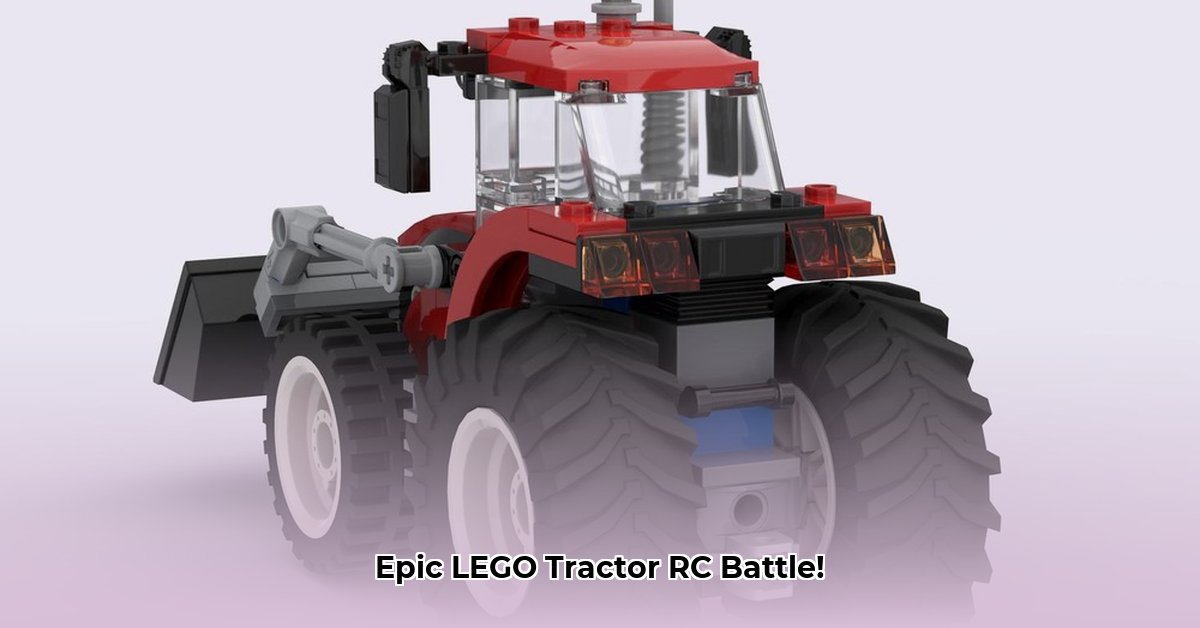
The Powerhouse (MOC-117708) vs. The Smooth Operator (MOC-164839): A Comparative Review
The world of LEGO Technic has exploded with incredible custom creations, and two magnificent remote-controlled (RC) tractor MOCs stand out from the crowd: the Powerhouse (MOC-117708) and the Smooth Operator (MOC-164839). This in-depth comparative review will dissect each model, examining their strengths and weaknesses to help you decide which ambitious project best suits your skills and aspirations. Whether you're a seasoned LEGO master builder or a curious newcomer, get ready to delve into the heart of this epic LEGO Technic showdown! For more inspiration, check out these tractor pulling games.
A Head-to-Head Comparison: Design and Functionality
The Powerhouse is a powerhouse indeed—a complex marvel of engineering utilizing a sophisticated pneumatic system (a system using compressed air for power) and an impressive eight motors. This translates to a vast array of realistic functions, making it the undisputed king of functionality. Imagine the satisfying whoosh of the pneumatic lift arms raising and lowering heavy loads! But this intricate design comes at a cost. Construction is significantly more challenging, demanding patience, precision, and a healthy dose of problem-solving skills. The intricate pneumatic system, while impressive, also presents a higher risk of troubleshooting during the building process.
In contrast, the Smooth Operator adopts a sleek, streamlined design. It leverages the newer PoweredUp system, prioritizing user-friendliness and a more manageable building experience. This approach makes it an excellent choice for builders seeking a rewarding project without the steep learning curve of the Powerhouse. While it may not boast the same sheer number of functions, its integrated features deliver a smooth, efficient operation. Isn't a satisfyingly simple build sometimes just as rewarding?
Control Systems: Power Functions vs. PoweredUp
The Powerhouse employs the classic LEGO Power Functions system. Experienced builders familiar with this system will readily appreciate its powerful, albeit slightly more intricate programming. Think of it as the classic muscle car – powerful but requiring more expertise to handle. However, for newcomers, this might feel more like driving a stick-shift for the first time.
The Smooth Operator, however, utilizes the modern PoweredUp system, offering an intuitive, app-based control experience. This system boasts a significantly easier learning curve, making it the ideal choice for those new to RC LEGO projects or those who prefer a more streamlined programming experience. This provides a smoother, more intuitive control, reminiscent of driving an automatic transmission.
Feature Breakdown: Functionality and Versatility
The Powerhouse's eight motors and pneumatic system translate into exceptional functionality and versatility. Its capability to handle a wide array of attachments positions it as the quintessential multi-purpose workhorse. Imagine the possibilities! However, this complexity also increases the potential for troubleshooting and maintenance.
The Smooth Operator, while not lacking in features, offers a more focused and integrated approach. While its versatility isn't as expansive as the Powerhouse, its refined functionalities are highly efficient and deliver a satisfying user experience.
Build Complexity and Maintenance: A Tale of Two Experiences
Building the Powerhouse is a significant undertaking, demanding patience, precision, and extensive time. The intricate pneumatic system, with its many small air lines, requires meticulous attention to detail. Maintenance, should issues arise, will also be a more complex process.
The Smooth Operator, on the other hand, significantly reduces the construction time and effort. Its simpler design makes it less prone to errors, requiring fewer troubleshooting steps and simplifying the overall maintenance process. A more straightforward build equals less frustration and more enjoyment for those who value efficient building.
Size and Scale: Giant vs. Compact
Given its advanced features, the Powerhouse boasts a larger scale. Builders with ample space and a desire for an impressive, imposing tractor will find this aspect particularly appealing. Its significant size is a true testament to the complexity of its design.
The Smooth Operator, crafted for a more compact footprint, is ideal for individuals with limited space or those who prefer a more manageable scale. Its more compact design allows for easier maneuverability and storage.
Technical Specifications: A Side-by-Side Comparison
| Feature | Powerhouse (MOC-117708) | Smooth Operator (MOC-164839) |
|---|---|---|
| Control System | Power Functions | PoweredUp |
| Motor Count | 8 | 4 |
| Pneumatic System | Yes | No |
| Implement Variety | High | Medium |
| Size | Larger | Smaller |
| Complexity | High | Medium |
Safety Considerations and Risk Assessment
Both models present inherent risks if not handled carefully. The Powerhouse's pneumatic system requires careful monitoring to prevent accidental pressure issues, demanding vigilance during both construction and operation.
The Smooth Operator, with its simpler design, presents fewer safety concerns. However, following manufacturer instructions and exercising appropriate care is still paramount, ensuring safe operation regardless of the chosen model.
Choosing Your Champion: Actionable Intelligence
The “best” LEGO tractor MOC depends on your individual skills, preferences, and available resources. The Powerhouse caters to experienced builders seeking a challenging yet highly rewarding project. In contrast, the Smooth Operator provides a more accessible entry point for newcomers and those who prioritize a more straightforward building experience.
Key Considerations:
- Skill Level: Assess your LEGO Technic building experience. The Powerhouse demands advanced skills, while the Smooth Operator welcomes builders of all levels.
- Desired Functionality: Do you prioritize a vast array of features or a smooth, efficient operation?
- Available Space: Consider the significant size difference between the two models.
- Budget and Parts Availability: Evaluate the costs and potential difficulty sourcing specific parts for each model.
Both MOCs offer exceptional value, providing a unique and rewarding building experience. The choice ultimately rests on your individual needs and aspirations. Happy building!